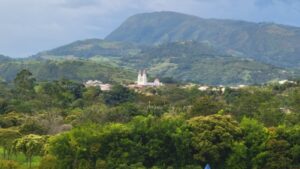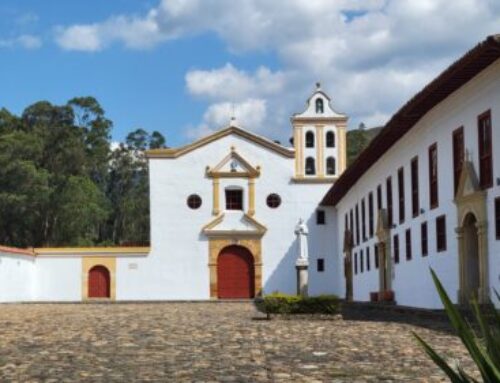Riding from Oiba to Barichara
Colombia is a magnificent destination and riding through the north eastern Andes is a brilliant way to see the marvelous scenery, indulge in the local cuisine and experience the varied cultures. After a couple of days in Bogota, which is all you need, you can stop and see some of the historic sites on the way to Oiba.
Getting to Oiba. One of the first stops that you will make is at Puente de Boyaca, the birthplace of Colombia’s independence. In 1819 a decisive battle was won against the Spanish, led by Bolivar and Santander, and a small bridge has been built to commemorate the battle, plus statues erected and other monuments. You’ll also have an opportunity to stop in Boyaca and try local arepas (these were my favorite of the entire trip) and the first of many hot chocolates. The scenery as you head north east is pastoral, with waterfalls and forests too.
Colombians absolutely love meat (and sugar) and at lunch on your first day you will have an opportunity to try a local favorite”picada” a plate of meats and potatoes that you pick at, served with arepas and soup, absolutely delicious and definitely very filling.
It’s a long drive to Oiba but Julio provides a good commentary on what you are seeing and you’ll also stop at a Paso Fino ranch where you can ride both Pasos and Trochas – amazing sturdy horses that expend so much energy they consume as much as 4 kilos of grain a day. It was dark and raining so my pictures didn’t do justice to the experience, but it’s great fun.



The ride
The horses, a mixture of Arabians, Arabian/Criollo and Anglo Arab mixes, are fleet of foot, healthy and willing partners that behave well and keep an endurance pace when asked. The tack is excellent and picked for horse comfort, I took a sheepskin seat saver and I recommend them. Along with Julio there are two assistants: Wilson who is the groom and a wonderful horseman that not only assures the horses are well but rides at the rear; and on this ride Rubiel as the support driver who not only took care of the horses ( assuring we had sufficient water for the horses along the way) but picking up meds, looking for lost phones and generally keeping an eye on us. This was the most safety conscious ride I have done anywhere in the world; walkie-talkie and phone communication between the team, safety briefings, daily temperature checks, first aid kits, insurance (with wrist bands for all) and vehicle escorts for the horses/riders through town – 5 stars.
The terrain was varied and interesting; depending on the elevation you can be riding through panela cane, bananas, cacao and coffee, to corn, fruit trees, pineapple, papaya, tobacco and custard apple. The footing is generally good and allows for long canters and trots, though more pavement being poured requires walking. There are some significant ascents on some days, along pilgrim trails – just grab mane and help your horses – and the views can be breathtaking. One of the highlights is on the last day when you ride to Chicamocha canyon through beautiful lanes and trails. The second largest canyon in the world, a staggering 6,000 feet deep, you get a wonderful view of the canyon as you approach and once the horses are settled at Rancho Alegre you can walk to the overlook before having a delicious bbq goat for lunch. You can learn more about this remarkable canyon at https://lacgeo.com/chicamocha-canyon-national-park-colombia
Rustic country food. I didn’t lose any weight despite a couple of long days in the saddle. Robust breakfasts – fruit, juice, eggs, arepas, hot chocolate (with cheese) and coffee; lunches that usually focused on local specialties – soups, goat, oreada – dried beef, fish and chicken, to dinners that also were not for the dieter – and not to forget beers, aguadiente and chocolate/pastry breaks. Water was plentiful with lots of opportunities to refill bottles.
This is a ride for fit riders, used to spending multiple hours in the saddle.



Accommodation
The first and last night are spent in a small hotel in Bogota, clean and simple, take ear plugs though. All of the places we stayed were clean and comfortable, ranging from small hotels to private country houses. Surprisingly there were swimming pools in Oiba, Charala, Paramo and Barichara. Wifi was available everywhere so easy to keep in touch and the cell signal was better than I get in California most of the time.
Culture
Julio excels at introducing riders to the local customs and culture. You will have the opportunity to experience local foods, learn about the history of each area, explore small towns such as Cabrera and Cinco Mil. Local guides are hired in the villages to explain their unique history, fauna and flora and you’ll be able to purchase mementos in many of the places.



Barichara
The ride ends in Barichara a well preserved Colonial town that is worthy of a day wandering around. In addition to the amazing cemetery and pretty church there are some interesting stores selling chocolate and coffee, baskets and clothing, plus a sculpture garden worthy of a walk. It’s a hilly city but easy to walk around. There are a number of restaurants and a good cappuccino can be found next to the church. Walking down to Guane, about 3.6 miles from the hotel, is a worthwhile trek to see the views and also the well preserved pueblo, and you can take a tuk tuk back up the hill.



Before you go:
- Contact Julio at Acaballo por colombia to get an up-to-date calendar and pricing
- If you are going in a couple of days early I can recommend a good guide for Bogota
- The traffic in Bogota is horrendous, leave lots of time to get into/out of and around Bogota
- If you live at sea level remember to leave time to adjust to the elevation
- You can bring coffee, chocolate, honey and artisan crafts back to the USA
- Bogota airport can be slow, especially for arrivals
- No matter the season take waterproof riding jackets
- I recommend a seat saver
- Water bottles are provided.
- You will be required to buy travel/health insurance
- Tipping is OK in US dollars, but local towns and merchants require Colombian pesos – get from an ATM or the airport
In summary: I unequivocally recommend this trip for adventurous, fit riders






